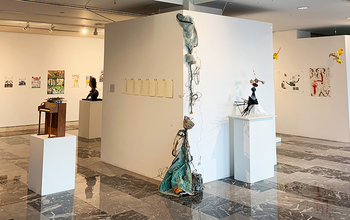In a collaboration with research scientists specialized in antibody discovery, artist Heather Dewey-Hagborg has created a custom retrovirus which infects its host with a gene that increases the production of oxytocin.
Oxytocin is a hormone secreted by the posterior lobe of the pituitary gland, a pea-sized structure at the base of the brain. The hormone oxytocin is implicated in feelings of love and bonding, monogamy and devotion, and the promotion of empathy and connection because it is released when people snuggle up or bond socially. Even playing with your dog can cause an oxytocin surge, according to a 2009 study published in the journal Hormones and Behavior.
“Lovesick” is envisioned as an activist intervention, to spread affection and attachment and to combat the alienation and disconnection of the present.
I am sure you have questions about how this love virus is made. So, first let’s understand how a virus works.
A virus is a small infectious agent that replicates only inside the living cells of other organisms. Viruses can infect all types of life forms, from animals and plants to microorganisms, including bacteria and archaea (Biology Direct).
In terms of our evolutionary path, viruses are an important natural means of transferring genes between different species, which increases genetic diversity. If you wanted to learn more on this topic, watching the documentary “the evolution of us” could be a great start. Viruses have been useful in the study of genetics and helped our understanding of the basic mechanisms of molecular genetics, such as DNA replication, transcription, RNA processing, translation, protein transport, and immunology.
Many viruses can be cloned or synthesized from scratch. Although somewhat of a misconception, it is not the actual virus that is cloned or synthesized, but rather its DNA genome. For many virus families the naked synthetic DNA is infectious when introduced into a cell. That is, the DNA contains all the necessary information to produce new viruses. This technology is now being used to create new vaccines and drugs (Spark Therapeutics).
Heather’s project involved creating a lentivirus vector that expresses the hormone oxytocin. The viral vector was designed to enter any cell, deliver the gene for oxytocin (as a precursor called neurophysin), and enable the cell to express and release the protein. The viral vector created for this project simultaneously expresses a fluorescent protein called dsRED that causes the cells to glow bright red.
In molecular cloning, a vector is a DNA molecule used as a vehicle to artificially carry foreign genetic material into another cell, where it can be replicated and/or expressed (e.g.- plasmid)
After all, DNA contains the genetic information that allows all modern living things to function, grow and reproduce. Because DNA collects mutations over time, which are then inherited, it contains historical information, and, by comparing DNA sequences, geneticists can infer the evolutionary history of organisms, their phylogeny. And now, by introducing “love” into the sequencing of a DNA, we are passing on a warm message to future generations. Couldn't the world use a little more love?
Heather’s research-based practice taps into biological data to highlight political and cultural questions of our time and further speculate the future of such conditions.“Acting as a kind of sequel to T3511, Lovesick examines desire and intimacy in a ubiquitous genomic future where biotechnology is inexpensive and accessible,” says Heather.
To find out more about Heather’s early ideas and past projects please read our earlier post.


